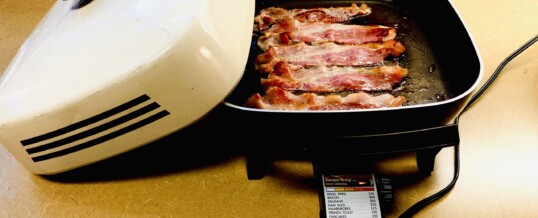
When Eisenhower, JFK, and LBJ were in office, rarely would you find a kitchen that didn’t have an electric skillet.
Waking up each morning to the smell of bacon, sausage, and fried potatoes was just how the world turned in 1960s Ashdown, Arkansas.
And an electric skillet was part of what made that possible.
Moms across the South used cast iron to fry up meals, but there were only so many skillets and spaces on the stovetop. That’s where the electric skillet came in.
Electric skillets might just be the perfect small appliance. Portable, temperature controlled, immersible and easy to wash, and you could take one with you on trips. And many families did.
Staying in roadside motels, to save money you could use an electric skillet to make grilled cheese or fried baloney sandwiches.
Often, the motel owners frowned on cooking in the rooms, but my dad frowned on spending money. The electric skillet could feed any size family, leaving extra dollars for souvenirs at Dogpatch, Silver Dollar City, Six Flags Over Texas or Astroworld.
It wasn’t uncommon to carry sacks of groceries on vacation and either eat in the motel room or at one of the once numerous, but now almost extinct, roadside parks.
We were preppers back then. We loaded the Buick with clothes, loaves of bread, cheese, and lunchmeat just in case.
Whether you left for a planned vacation, parts unknown, or just stayed home; an electric skillet seemed to be as common as a breadbox.
General Electric, Sunbeam, and other great American companies made electric skillets with some variations between them, but they all shared a basic design: a square or round shaped base with four legs, handles, a lid with a handle and vent, and a knob to control the temperature.
The later models often included a cooking guide. On the handle or temperature controller, you’d find a list of mostly breakfast items, and the temp at which you should cook them.
This was likely one of the earliest Cooking For Dummies guides.
It was difficult to make a mistake with an electric skillet. Cook your sausage or bacon first, and you had renderings to fry your eggs.
If you wanted to make pancakes, toast, or french toast, you could do that too.
And if the kids came running in, nasty and sweaty at midday wanting dinner (in the South, lunch is called “dinner”), mom could quickly and easily whip up some grilled cheese sandwiches using Holsum or Wonder Bread, a thick slice of cheddar, and some real butter. Add a glass of whole milk (we’d never even heard of skim or low-fat milk) and you had a meal.
Good eatin’ for growing children.
My father arrived promptly at 5:30 each evening. You could hear the sound of the six-cylinder engine as he glided his 1952 Chevy truck into the driveway.
He’d hug each of us as he entered through the screen door, and then comment on the smell coming from the kitchen.
The smell was almost always from the chicken fried steak and fried potatoes wafting from the electric skillet.
Mom’s electric skillet was made by General Electric. It was aluminum, which conducts heat exceptionally well. Later models had Teflon, but mom’s was old school. She used it until a few years ago and then it seemed to disappear. I asked her about it.
She told me that it had begun to have problems, so she disposed of it. It lasted over 60 years.
I began to look for another one.
They still make electric skillets, but just like Crockpots, the older ones are made a lot better. And I found one at a secondhand store. A Sunbeam.
Its color scheme and graphic design indicates a late 60s or early 70s manufacturing period. The gold and brown, and font selection makes it obvious. But the build quality also confirms its age.
After a good cleaning, a test run of bacon, sausage and eggs came out right nice.
Now we just need some Holsum or Wonder Bread, cheese, baloney, a Buick, and a roadside park and we’re all set. You up for a road trip?
©2023 John Moore
John’s books, Puns for Groan People and Write of Passage: A Southerner’s View of Then and Now Vol. 1 and Vol. 2, are available on his website – TheCountryWriter.com, where you can also send him a message and hear his weekly podcast.
MAR
2023
